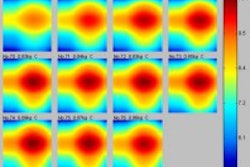Women in the Chinese-American community have very specific rules when it comes to breast cancer screening, according to a new survey. They are more likely to have a mammogram if they are told to do so by their primary care physician -- particularly if the referring doctor is female and is fluent in a Chinese language.
Such narrow criteria for cancer screening acceptance could be problematic in a community where the occurrence of breast cancer is markedly high. Researchers from the Pacific Northwest tracked the habits and perceptions of Chinese women with regard to breast cancer screening. Their results appear in the March 1, 2003 issue of Cancer.
"Epidemiologic studies have demonstrated an increased risk of breast carcinoma in Asian women after migrating in the U.S.," wrote Dr. Shin-Ping Tu and colleagues from the University of Washington and the Fred Hutchinson Cancer Research Center in Seattle. Researchers from the British Columbia Cancer Agency in Vancouver also contributed to the study. "Among several Asian-American populations, breast carcinoma is the most common major malignancy and the leading cause of cancer mortality" (Cancer, March 1, 2003, Vol. 97:5, pp.1293-1302).
According to another survey, this one in San Francisco, only 73% of Chinese women reported prior mammogram screening, compared to 93% of white women (Health Education Quarterly, 1996, Vol. 23: Supplement, pp. S10-S27).
In order to determine why Chinese women might shy away from breast cancer screening, Tu and colleagues launched a community-based survey in the Seattle area in 1999. In addition to assessing the women’s mammography screening behavior, they also looked at perceived personal risk, as well as the benefits of breast cancer screening modalities.
Eligible candidates had to be 20 years or older and fluent in Cantonese, Mandarin, or English. The interviews were conducted at the women’s homes by bilingual Chinese-American females who asked the participants to specify how long they’d lived in North America; attitudes regarding breast cancer; and their perception of clinical breast exam (CBE), breast self-exam (BSE), and mammography. Outcomes variables included whether the women had ever had a mammogram or whether they’d had one in the previous two-year period.
The final number of participants was 710; the mammography section was restricted to women ages 40 and up (375 out of 710 women). The mean age was 58. The majority of women had been born in mainland China and had lived in North America for about two decades.
According to the results, 74% of the women reported having a mammogram; 61% stated that they’d had a mammogram in the last two years. A lack of fluency in English and having lived in the U.S. for less than 25% of their lifetime were two reasons that the women said they did not undergo breast cancer screening, the authors found.
"Recommendation by a physician or nurse greatly increased the odds of a prior screening compared with no recommendation," they wrote. "Having language concordance with a female Chinese physician was associated strongly with ever having had a mammogram…. In fact, language concordance in English with a physician and language concordance in Chinese with a female physician both were found to be correlated positively with recent screening."
In terms of screening methods, 33% of the women considered BSE or CBE as the best way to detect breast carcinoma. Nearly 40% of the women said that they did not know about, or were unsure of, their breast cancer risk.
"Other variables that were associated negatively with a prior mammogram included never being married and concerns about financial costs," the paper stated.
Interestingly enough, strong religious or cultural convictions among the women did not automatically mean a negative attitude toward cancer screening.
"Women who believe that malignant disease was caused by imbalances of yin and yang were less likely to be screened; whereas women who believed that malignant disease can be caused by poor qi and blood circulation had significantly greater odds of screening," the authors explained.
For mammographers, there are several take-home messages from this study in terms of how to encourage breast cancer screening in a Chinese-American population:
- Educational materials should emphasize the benefits of mammography compared with BSE and CBE.
- Free breast cancer screening services are still valuable to low-income women in immigrant communities.
- A patient’s belief in Eastern philosophy and healing methods does not preclude them from seeing the value of mammography.
- Chinese women respond positively to feedback from female primary care physicians, particularly if the doctor and patient are both comfortable in a common language. However, a Chinese-American woman is no more apt to listen to a male physician, even if he speaks a Chinese language.
The key to introducing mammography services lies with referring physicians, the authors concluded. "Efforts to effectively promote screening through the provider, regardless of their ethnicity or language concordance, should be explored further," they wrote.
By Shalmali PalAuntMinnie.com staff writer
February 19, 2003
Related Reading
Non-whites in U.S. at greater risk for advanced breast cancer, January 14, 2003
Race still a factor for cancer survival in the U.S., September 24, 2002
Breast cancer rates for Asian-American women climb, June 12, 2002
Doctors skip breast exam before mammo referral, April 24, 2002
Grassroots groups address high breast cancer rate among immigrants, March 30, 2001
Copyright © 2003 AuntMinnie.com



















